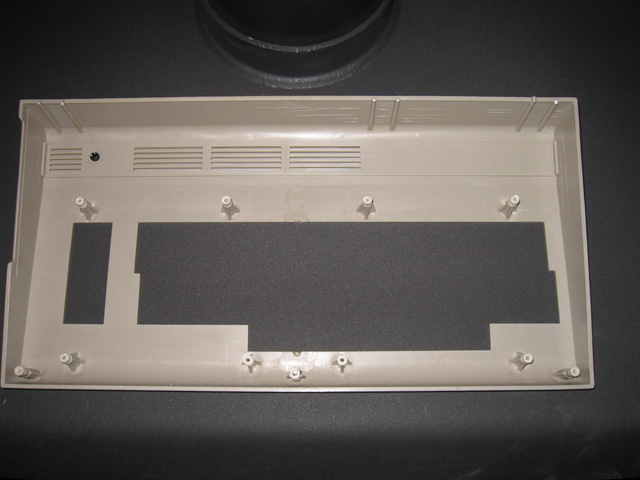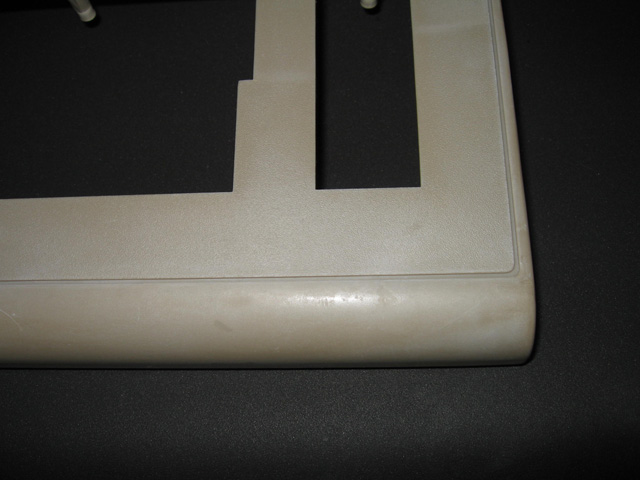De-yellowing old computer cases: Arrowroot vrs xanthan gum/glycerine, and why heat and fast drying conditions are best avoided
Introduction
My past de-yellowings have used a paste made from a common food thickener called Arrowroot. I used Arrowroot rather than Xanthan gum (as previous people had done), as I couldn't easily find the latter. Arrowroot worked well on my cases to date (see other blog entries). However, other folk who had compared the two found the Arrowroot dried quicker than Xanthan gum/glycerine and was also less transparent.
Another thing observed is that with high concentrations of peroxide, local whitening or bleaching of the case could occur. The theory is that under the hot drying paste in the sun, the hydrogen peroxide would become concentrated and attack the plastic directly.
This test initially sought simply to compare the Arrowroot and Xanthan gum/glycerine paste. However, eventual results also strengthens the theory that allowing the paste to dry for long periods under the hot sun can lead to uneven discolouration and a bleaching of the case (as opposed to simply reverting to the original colour).
The treatments
Two pastes were made up. My own recipe using Arrowroot and Lorne's Xanthan gum/glycerine variation from the original recipe. During the treatment period these were applied at the same time to a side of the test case (Xanthan gum/glycerine left side, Arrowroot, right side).
A mahogany coloured Commodore 64 case was used for the trial. A band of tape down the middle was used to separate the two treatments.
Treatment was over four days inside using the New Zealand sun as a UV source and one day in a humid chamber sealed with cellophane under a UV lamp. UV levels were very inconsistent over the first four days due to cloudy weather. For the days outdoors, the paste was reapplied every two hours or so, with the exception of the second day, where the case was left in the sun for a whole day with just one application (as I had run out of ingredients).

Photo 1. Xantan gum/glycerine on left, Arrowroot on right.
The Arrowroot paste did appear to dry faster than the Xanthan gum/glycerine mix, leaving a kind of flaky layer on the plastic. The Xanthan gum/glycerine mix was relatively clear, and stayed moist longer.
The following table details the treatment.
| Day | Conditions | Temperature (approx) | Applications |
| 1 | Cloudy, dim, weather. Light drizzle sometimes | 20 deg C | 5 |
| 2 | Sunny, a breeze. Good drying conditions | 22 deg C | 1* |
| 3 | Partly cloudy. Sun visible 40% of the time | 20 deg C | 5 |
| 4 | Sunny, a breeze. Good dry conditions | 25 deg C | 5 |
| 5 | Under a UV lamp in a humid chamber (paste remained moist all day, no further applications required) |
18 deg C | 1 |
* Early in the day
Results
Photos 2, 3 and 4 show the case at the beginning of the trial, after day two and at the conclusion after day five.

Photo 2. Case before trial

Photo 3. Case after day 2. I believe this is where the damage occurred. A hot day, and paste was allowed to dry out. Note the bleached areas.

Photo 4. Case at the conclusion of the trial
Both pastes caused the case to revert to it's natural colour. However, with both the Xanthan gum/glycerine and Arrowroot, the result was not as smooth and uniform as the original grey/beige colour, which could be found on the inside of the case

Photo 5. Original colour of the case
There were areas where the case had whitened, beyond it's natural colour. Although subtle, some of the textured areas had a kind of "white bloom" when examined carefully.

Photo 6. Bleaching symptom from paste drying out in the hot sun
This occurred using both pastes, but seemed to be a little more pronounced with the Arrowroot. Wetting the plastic would make this phenomena disappear, but it would return on drying. It appears to be a similar symptom to that mention in item 1 under "Problems and Pitfalls" in The RetroBright Wiki.
Discussion
Both pastes de-coloured the case successfully. Arrowroot certainly dried faster. It would be interesting to know if the addition of glycerine would slow this.
However, with both pastes the de-colourisation was not uniform and even. Some patches are lighter than others. The light patches appear lighter than the original colour and may be a result of the peroxide attacking the plastic itself.
My thoughts are the damage may have occurred on day 2, when the case was left for a long period with just one application. These lighter patches could already be seen after that day (see photo 3 above). It's possible that under high drying conditions, the local concentration of peroxide on the surface in some areas became very high, and bleached the plastic.
Assuming the theory as to why the bleaching occurs is correct, it would be wise not to let the cases dry out under strong sunlight. On a white case, bleaching might not be visible but a UV bulb and no added heat may be the prudent way to go with a valued case whose natural colour is anything other than white.
Summary
- Xanthan gum/glycerine and Arrowroot both de-yellow cases to a similar extent. However, Arrowroot dries out faster. This does not seem to effect its rate of de-yellowing but it can give a slightly (but not significantly) patchier result than Xanthan gum/glycerine.
- Both pastes may cause a slight bleaching some plastics under fast drying conditions with heat (e.g. strong sunlight)
- A UV light, no heat and repasting when the paste appears to be drying out would be prudent for a valuable case.
I hope this experience adds to the knowledge base regarding this process.
Tez
22nd March, 2009
| Tweet |